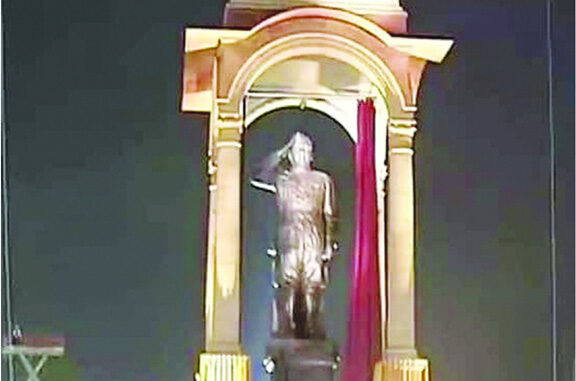
New Delhi (TIP)-The famed canopy of India Gate where a grand statue of freedom fighter Subhas Chandra Bose was on Thursday, September 8, unveiled marked a milestone transition in the history of India, as ‘Netaji’ was accorded a place that was once occupied by an imposing marble statue of British monarch King George V.
The canopy, standing on four columns of the Delhi Order devised by Sir Edwin Lutyens, had been lying empty since the statue of the king was removed in 1968.
Prime Minister Narendra Modi on Thursday unveiled the 28-ft-tall statue of Bose, and also inaugurated the newly-christened ‘Kartavya Path’, the stretch of road from Rashtrapati Bhavan to India Gate, earlier known as Rajpath.
Kingsway or Rajpath, was a “symbol of slavery”, and it has now been consigned to history, Modi said after inaugurating the Kartavya Path, and also mentioned the king’s statue that had occupied the canopy. Official sources had earlier said that the installation of the statue would be a case of India “reclaiming” its history and shedding a part of its colonial past. Before the ‘monarch’ was relegated to the grounds of the Coronation Park in northwest Delhi—the site of the 1911 coronation durbar, till 1968, he stood under the canopy watching the India Gate, Kingsway—the ceremonial boulevard that ran up to the Raisina Hill on which the president’s house is built.
Soon after Independence, Kingsway was renamed Rajpath and Queensway running perpendicular to it was rechristened Janpath. Rajpath on Wednesday was officially renamed Kartavya Path.
The statue of George V was unveiled in 1939 by the then Viceroy Lord Linlithgow as a memorial to the British monarch under whose reign ‘New Delhi’ was built as the British Raj’s capital, according to archival records.
Born in 1865 in London, George V was crowned as king in 1910, and the next year, he travelled along with his consort Queen Mary to India to attend the famous 1911 Delhi Durbar, where he had also announced the shifting of the capital to Delhi from Calcutta. King George ruled until his death in January 1936, after which memorials were built and statues erected in various cities under the British Empire, the most notable among them being New Delhi—the administrative seat of a country, which was held as the ‘Jewel in the Crown’.
The statue, crafted out of white marble, was designed by famous British sculptor Charles Sargeant Jagger, and its models were exhibited in 1933 and 1935 at the Royal Academy, according to victorianweb.org, a scholarly resource.
Jagger died in 1934 before he could complete his work, which was then completed by other artists, it says.
According to the archives, the statue of George V beneath the canopy, endowed with royal motifs and surrounded by a pool of water, was unveiled by the then viceroy on November 14, 1939. “The King was everybody’s King. More particularly can we who are gathered here be sensible of this personal relationship with the Sovereign, who 28 years ago announced his decision to restore Delhi to its ancient birthright and who laid the first stones of his Imperial Capital,” Viceroy had said in his speech, according to the Indian Information published in 1939.





Be the first to comment